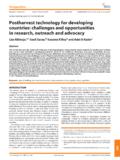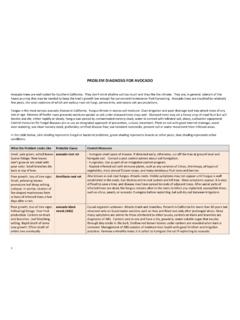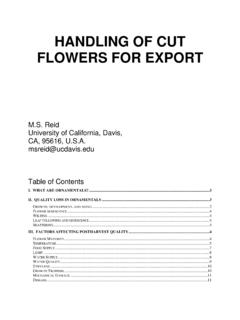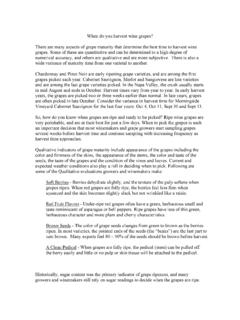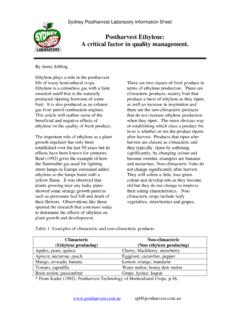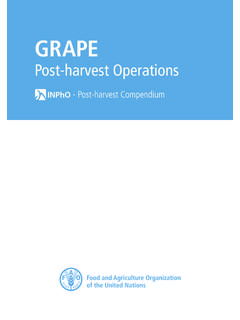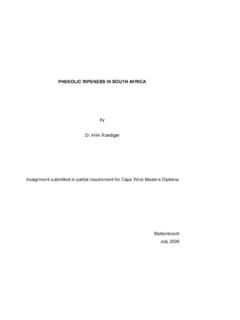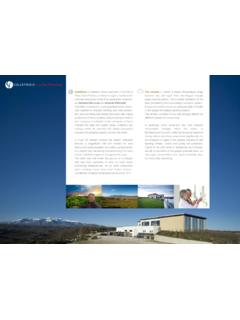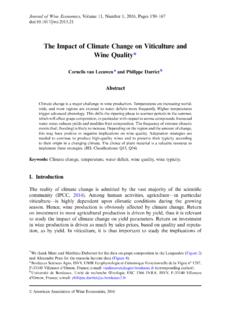Transcription of 9 Grapes - University of California, Davis
1 187 Crop Post-Harvest: Science and Technology, First Edition. Edited by Debbie Rees, Graham Farrell and John Orchard. 2012 Blackwell Publishing Ltd. Published 2012 by Blackwell Publishing Chervin, Julia Aked and Carlos H. CrisostoINTRODUCTION, BOTANY, CULTIVATION AND PRODUCT STATISTICSI ntroductionThe grape was one of the first fruits to be cultivated by man. Since the dawn of civilisation, the fermented product of Grapes , wine, has probably been an important way of con-suming Grapes (McGovern et al. 1995). Wine residues have been identified in 7000-year-old jars in Iran (McGovern et al. 1996). However, consumption of the fresh and dried fruit has probably always been popular where the vines grew chapter provides some basic information about the cultivation of Grapes (this section) before looking at the physiology and biochemistry of the developing and mature grape berry.
2 The final three sections of the chapter deal with post-harvest aspects of Grapes pertaining to the three main product types: beverages (wine and juice), fresh fruit (table Grapes ) and dried fruit (sultanas, raisins and currants). Although today most Grapes are converted to wine, the development of the post-harvest technology for Grapes has concentrated on the fresh fruit. This is because all the eating-quality parameters (appearance, texture and taste) must be high in the commercial product. The quality of Grapes for wine, drying or for other grape products is primarily dependent on harvesting the right varieties at the right time and preventing unwanted chemical changes during processing.
3 The topic of wine production is so huge that this chapter describes only the quality factors required in the harvested grape as the basis of a good wine. Details of processing are omitted but references are given for further reading on this topic. There is relatively little published on the specific post-harvest requirements for Grapes used for drying. In the section entitled Post-harvest technology for dried Grapes , a summary of the basic processing and product preservation is grape plant is a vigorous vine of the family Vitidaceae Juss. (syn. Ampelidaceae; Vitacae) (Watson & Dallwitz 1991, 1992). The European grape Vitis vinifera (L.) is hermaphrodite whereas some native North American Vitis species are monoecious.
4 Multiple buds are produced laterally on the previous season s cane and flowers are wind pollinated. The fruit clusters mature about 5 7 months after bud burst. The main cultivars in commercial production are described in the product sections is one of the world s most widely grown fruit crops in relatively warm temperate-zone climates (see product statistics below). It is not well adapted to subtropical or tropical areas although special management allows dessert Grapes to be harvested 2 4 times per year in tropical countries such as Thailand and Indonesia. Heat accumula-tion determines the type of grape that can be successfully grown. Between 950 C day and 1500 C day wine production predominates; above 1500 C day table Grapes and fortified wines can be produced and above 1950 C day table Grapes and dried fruit are dominant (Jackson & Looney 1999).
5 18711/19/2011 9:13:19 AM11/19/2011 9:13:19 AM188 Crop Post-Harvest: Science and TechnologyV. vinifera is the dominant species for wine, fresh fruit or drying. This species is thought to originate in the Caucasus Mountains. Of the N. American species, some are used for juicing, some for rootstock and some interspecific hybrids for wine or dessert usage (Jackson & Looney 1999). The selection of sports and hybridisation has traditionally been the only methods of breeding V. vinifera, but they are slow because the grape has a long life cycle and high inbreeding depression (Gray et al. 1992). Over the past decade, a wide variety of molecular techniques have been developed to improve the identification, breeding and the study of genetic relationships among cultivars (Lefort & Roubelakis-Angelakis 2000; Reisch et al.)
6 2000) and the grape genome sequencing (Jaillon et al. 2007) is leading to intense works in the grape research vine has deep roots and is drought tolerant although irrigation is necessary in some production areas. It is also tolerant of many soil types provided they are deep and well drained. Over-fertilisation, especially with nitrogen can lead to too vigorous growth (which may adversely affect wine quality). The vine and developing fruits are suscepti-ble to a number of pests and diseases (Pearson & Goheen, 1988). Some recent concerns have emerged about salt concentrations rising in soils of irrigated vineyards, and their effects regarding the choice of rootstocks and fruit quality have been studied (Walker et al.
7 2007). In Europe and the United States, it is normal to use root stock resist-ant against the aphid Phylloxera vastarix which has caused large losses in these regions. Nematode-resistant root stock is also recommended. Fungal diseases can dramatically affect production. During wet weather, grey mould (Botrytis cinerea), downy mildew (Plasmopora viticola), anthracnose (Elsino ampelina) and phomopsis (Phomopsis viticola) can be serious. Powdery mildew (Uncinula necator syn. Erysiphe necator) can occur in both wet and dry regions. Crown gall (Agrobacterium spp.) is the most serious bacterial disease, and there are a num-ber of viruses that damage the vine (Jackson & Looney 1999; Patil et al.
8 1995).Classic texts on vine cultivation include Winkler et al. (1974) and Mullins et al. (1992). Other textbooks include Huglin and Schneider (1998), Jackson and Looney (1999), Reynier (1999) and Jackson (2000).Product statisticsWorld production of Grapes in 2009 was estimated to be about 68 million metric tonnes (MT). The main producer countries were, in order of decreasing production volumes, Italy, China, the United States, France, Spain, Turkey, Chile, Argentina and India (FAO 2009).Approximately half of the Grapes are transformed into wine. The world production of wine was about 27 MT (rep-resenting around 36 MT of Grapes ) with the main producer countries being (in order of decreasing productivity): Italy, France, Spain, the United States, China, Argentina, Australia, South Africa, Chile, Germany and Portugal (FAO 2009).
9 Of this production, about a quarter is exported. Leading exporters were: France, Italy, Spain, Chile, Australia, the United States, Germany, Portugal and South Africa. Only million MT of unfermented grape juice was exported world-wide, with the main exporters being Italy, the United States, France, Spain, Argentina, Germany, South Africa and Chile (FAO 2002).The remaining 32 MT of Grapes are either table Grapes or raisins (detail unknown). World export volumes of table Grapes were in the order of million MT with the main exporter countries being Chile, Italy, the United States, South Africa, Mexico, the Netherlands, Greece and Turkey (FAO 2002).World export volumes of raisins were in the order of million MT.
10 The main exporters are Turkey, Iran, the United States, Greece, Chile and South Africa (FAO 2002).MORPHOLOGY AND PHYSIOLOGYI ntroductionGrape berry physiology and biochemistry was last reviewed in detail by Conde et al. (2007) and formerly by Ollat et al. (2002). The mature grape berry is a nonclimacteric fruit with a low rate of post-harvest physiological activity. Grapes must therefore be harvested after they have reached optimum levels of colour development and of important solutes such as sugars and acids. Ripening changes occur in a relatively dramatic fashion during the development of the berry on the vine. These changes resemble, in a number of respects, those seen in climacteric fruit after harvest (see section on Berry development ).
